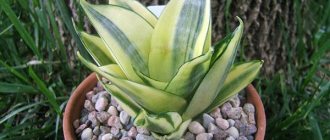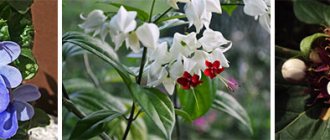Coffee grows in the form of small trees. This is an evergreen plant with hard grain-like fruits (the photo shows that they ripen like berries). They can be of different colors - from burgundy to dark brown.
The coffee tree grows only in warm countries. It has several species, but even more are hybrid varieties that have become more widespread. Some can be grown at home.
Placement nuances
The tropical origin of the plant does not mean that it must be placed in a south-facing window under the scorching sun. In excessively hot conditions, the tree runs the risk of not blooming. It is better to protect the plant from direct rays, but organize the lighting carefully.
If the location of the room faces north or west, then the flower is placed on the windowsill. In rooms facing south and east, the pot is removed from the window opening up to 1.5 m.
Be sure to remember that the coffee bush should not change its location. Turn the pot with the “pet” once every five years. To make the formation of the bush symmetrical, it is permissible to install a mirror next to the plant that will not reflect direct sunlight.
Conclusions:
- A coffee tree can be easily grown at home: from green seeds by soaking, but easier - from sprouts, which are sold in garden centers or in online stores.
- For coffee, high air humidity, watering with warm water, and morning sunlight are important.
- The soil should be porous, loose, and add pebbles or sand for drainage.
- It is important to replant the plant in time so that a developed root system is formed.
- First use nitrogen fertilizers to stimulate growth, then buy mixtures for citrus or orchids.
Water treatments
To ensure proper care, it is useful to know how to water a flower. The coffee tree needs a sufficient amount of moisture, but will not tolerate liquid stagnation in the soil. This can cause the roots of the plant to rot. This development of events can be counteracted by proper drainage.
Lack of moisture quickly affects the appearance of the tree. The plant becomes lethargic and drops its leaves. Once the soil is moistened, the situation quickly returns to normal.
Watering is carried out according to the schedule:
- in summer every 2–3 days;
- in winter no more than once a week;
- For control, soil drying is tested at a depth of up to 1 cm.
During the warm period, be sure to spray the foliage. This should be done every 1–2 days. To remove dust, the greens can be additionally wiped with a damp cloth. For all water procedures, settled water is used, which is 2-3 degrees higher than the ambient temperature.
Flowering conditions
The coffee tree blooms in spring. It forms umbrella-shaped inflorescences consisting of small white flowers. At the same time, the tree emits a pleasant aroma.
REFERENCE. The coffee tree fades very quickly. Don't miss this amazing moment!
Flowering
You can also help the plant bloom. To do this, gently shake the branches on which the inflorescences appeared. Another way is to take a cotton swab or soft brush and touch the flowers. This will cause artificial pollination.
After flowering, fruits begin to set. They ripen almost throughout the spring-summer period, and in some cases the process can even take 1.5 – 2 years.
IMPORTANT! In order for coffee to bloom bright and memorable, it needs to be allowed to rest in winter. During the dormant period, you will have to reduce watering and eliminate the application of fertilizers. You also need to slightly reduce the temperature.
Choosing soil for a plant
The description of the flower must indicate that it prefers acidic soil. The pH level of the medium should be in the range of 5–5.5. It is easiest to use a ready-made substrate. Blends intended for citrus fruits are ideal for the coffee tree.
You can create soil by combining:
- 1 part peat;
- 2 parts coarse sand;
- 2 parts leaf soil;
- 4 parts manure humus;
- 4 parts of turf.
Additionally, add some crushed sphagnum moss. You can check acidity using litmus paper. If the indicator is violated, the soil must be artificially acidified.
Usage.
The main product obtained from coffee beans is a drink, i.e. actual coffee. In recent decades, the share of instant coffee consumed in the United States and other economically developed countries has fallen sharply. This is associated with a change in the taste standards of the population and fear of widespread surrogates. At the same time, there was a decrease in the share of consumed decaffeinated coffee. People have become less afraid of the harmful effects of caffeine, and in addition, there are reports that even decaffeinated coffee increases cholesterol levels in the blood.
Coffee is also used as a flavoring component in baked goods, ice cream, candies and liqueurs.
Feeding schedule
Caring for a coffee tree indoors necessarily involves fertilizing. Special complex fertilizers are suitable for this purpose. You can make a solution based on chicken droppings yourself.
Fertilizing is done regularly. In the warm season, this is done about twice a month. In winter, procedures are not carried out more than once every 30 days. When flowering, the tree can be additionally fed with fertilizer containing potassium.
If the foliage begins to fade, then it is permissible to wipe it with lemon juice. Make a solution: a liter of water and 2–3 tsp. citrus squeezes. It is useful to pour the remaining liquid into the soil. It is not recommended to do this procedure more than once a month.
Popular varieties
Scientists count more than 100 types of coffee. Plantation owners often cultivate Arabian and Congolese varieties. Hybrids of these varieties are also grown.
Arabian
The Arabian variety has become widespread. It blooms 2 times a year. Under natural conditions, Arabica reaches 7-8 m in height.
For home breeding, a dwarf variety is used, the height of which does not exceed 0.8 m.
Congolese
Congolese coffee is called Robusta, which means “strong”, “strong”. The variety is resistant to diseases and pests. Robusta is easy to care for and has high yields. The Congolese variety has a higher caffeine content. But its taste is lower than that of other varieties. Robusta is added to coffee blends.
Congolese coffee is easy to care for.
Liberian
The variety was discovered in Liberia. The first plantation appeared in 1864. Coffee was first planted in the Philippines. He was then transported to Indonesia. Here, the Liberian variety replaced the Arabica, which was destroyed by bad weather conditions. The grains have a strong aroma, but have a weak taste. For this reason they are used in mixtures. The caffeine content of the Liberian variety is reduced.
Transplantation and formation of a bush
Caring for a coffee tree at home is impossible without regular replanting. The young plant changes its place of residence annually. The tree is moved into a pot that is 5–6 cm larger in diameter than the previous one.
An adult plant over 3 years old requires replanting less often. The procedure is usually performed no more than once every 2–3 years.
It is important to choose the right moment. Transplantation is not done during flowering or fruiting. After harvesting, the right time comes for this procedure.
Coffee trees are replanted using the transshipment method. The plant is moved to a new location along with the existing earthen lump on the roots. Coffee trees are usually planted in groups. As it grows, a lush bush is formed, the crown of which must be decorated. To do this, pruning is done at the end of winter or beginning of spring.
In addition, height restrictions may be required. To do this, pinch the top or perform a constriction. After this, the plant acquires a spherical shape, the crown becomes thick and lush.
Where does coffee grow?
In one of the previous articles, we already talked about the famous coffee belt of the planet, which fully meets the coffee needs of earthlings. Let us recall a few basic provisions.
- The historical homeland of the coffee tree is Africa, or more precisely Ethiopia. There is an assumption that in Yemen culture grew independently. All other regions received coffee plantings as a result of human activity.
- Coffee trees are grown in the Tropics of Cancer and Capricorn, as the climate in these parts of the globe is ideal for the rather capricious plant.
- Coffee is grown in more than six dozen countries, in which dozens of varieties are cultivated.
- The main industrial coffee regions are Africa, South and Central America, and Southeast Asia. They produce most of the grains that go on sale.
- There are about 7 billion coffee trees growing on our planet. Therefore, we can assume that for every inhabitant of the Earth there is one tree with coffee fruits.
Coffee tree propagation
The easiest way to acquire a coffee tree is to purchase a ready-made bush in a store. It is important to carefully evaluate the condition of the specimen. After purchase, the plant is closely monitored for some time, separating it from the rest of the home plantings.
If no negative signs are visible, then the newcomer is transplanted to a permanent place. You can try to propagate an adult plant by separating a cutting from it. To do this, cut off a branch with 2 pairs of leaves. The cut is made approximately 3 cm below the bud.
It is recommended to treat the exposed base with any means designed to stimulate rooting. The branch is placed in moist soil. The seedling is covered with an improvised greenhouse. A hole is left in the bag through which it is regularly irrigated with warm water.
Rooting is considered complete after the appearance of a new pair of leaves. You can also grow a tree from a berry or seed. This process is long, but with the right approach it will be crowned with success.
Rejuvenation
Unfortunately, about 10 years after planting, coffee begins to age. The decorative value of the plant decreases. The leaves become yellowish and limp. So, it's time to rejuvenate.
To do this, cut the stems. The procedure must be carried out with a sharp instrument so that the cuts are neat and even. Do not break the shoots under any circumstances! Even if the tree survives, it will finally lose its decorative effect and become ugly.
Don't forget to treat the cut areas with crushed activated carbon.
ON A NOTE. By the way, cuttings are taken from the cut branches for propagation.
Diseases and difficulties in growing
Proper care at home usually does not lead to tree disease. The only thing is that greens can be attacked by spider mites. The fight against it is carried out using special drugs. Operate according to instructions.
Other painful conditions are usually associated with improper care. Each condition should be considered separately, its causes should be understood, and the conditions should be adjusted accordingly.
Looking at the photo of a coffee tree, it becomes clear how impressive this plant is. It will be an excellent addition to any interior. In this case, this option will not cause trouble when growing.
How to resuscitate?
If your coffee tree is sick, you can try to save it. Depending on the condition of the plant, there are two effective methods:
- Transfer;
- Rooting cuttings.
If you have “flooded” a flower, you can save it by replanting it in a new pot. To do this, be sure to clean the roots from the old soil, treat them with potassium permanganate, sprinkle with activated carbon and carry out the procedure itself.
Please note that old soil cannot be used.
If the transplant does not help and the plant continues to wither, then the only chance is to cut healthy cuttings and root them. Alas, the old plant cannot be saved.











